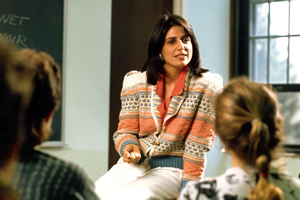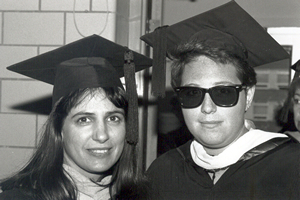Note: This is the 27th profile in a series of 90 stories highlighting individuals who have shaped Notre Dame and/or live the College’s mission of personal, professional and global responsibility.
By Christian Taske ’07
Every once in a while a student walks into a teacher’s life and in a sort-of role reversal has a profound impact on the teacher. For Associate Professor of Fine Arts Rachel Morris that student was Margaret Kocevar ’90.
Kocevar took several of Morris’s art history classes, and Morris remembers her as someone who loved life and had deep compassion for others. She became friends with Kocevar and “Maggie” babysat Morris’s two daughters for eight years. During that time Morris learned Kocevar was keenly interested in the Holocaust. At lengthy dinner conversations they talked about her idea of founding a center dedicated to Holocaust studies. But before she could realize her dream Kocevar died of a cardiac condition at age 27.
A year later, in 1997, Kocevar’s boyfriend told Morris he had found a grant proposal on her computer for establishing a Tolerance Resource Center at Notre Dame College. Determined to not let the idea die, Morris took it upon herself to see Kocevar’s vision through. With the help of Professor Mary Louise Trivison ’50 and Library Director Karen Zoller, she established the Center in November 1997 and began over a decade of volunteer work in Kocevar’s memory.
The establishment of the Tolerance Resource Center is among Morris’s best known contributions to the College. In addition, over the past 27 years she has shaped the fine arts at Notre Dame as professor, department chair and art gallery director.
But what’s most important to Morris is the impact she has had on the lives of countless students, many of whom she stays in touch with long after they graduate. Some, like Kocevar, in return have shaped Morris and inspired her to dedicate her professional life to the College’s mission of educating students for personal, professional and global responsibility.
“Once you are here for a while you start to absorb that mission and you start to live that mission,” Morris says. “It’s no longer just a job. It becomes an important component of who you are.”
Morris says she got a sense of that mission as soon as she stepped onto Notre Dame’s campus as an adjunct art instructor in 1985.
“When I first came here there were still a lot of the Sisters of Notre Dame here. They were wonderful role models and really agents for the mission of the College,” Morris says. “They were so supportive and encouraging of whatever I did. That made an impact.”
Morris immediately felt comfortable at NDC because she had experienced a similar sense of community at Seton Hill University, where she earned her Bachelor of Arts.
“The Sisters of Charity there were also excellent role models,” she says. “So I felt really comfortable with the Sisters of Notre Dame. I related really well to them.”
 |
| Rachel Morris in 1989. |
Morris arrived at NDC as an adjunct instructor after earning her Master of Arts in Art History at Case Western Reserve University. The part-time position was perfect for Morris since she had a 4-year-old daughter and had her second child three years into the job.
But in 1990, with two young children, Morris was unexpectedly promoted from part-time professor to chair of the art department.
“I didn’t expect to become department chair as soon as I did,” Morris says. “It was really scary.”
Morris was the only full-time employee in the art department at the time. She worked with adjunct professors Malinda Smyth, Sr. Megan Dull ’71 and Lisa Schonberg on curriculum changes and other administrative tasks.
“We all made decisions together because we really were the art department,” Morris says.
Under Morris’s leadership the art department has grown over the years. There are now about 50 art students enrolled at NDC, compared to about 10 in 1990. The College added a graphic communication and a graphic major, several minors and numerous courses. In 2010 it redesigned the majors to include concentrations that have attracted more students interested in art therapy and graphic arts.
Morris teaches many of the art courses and has been recognized by her peers and her students as an excellent educator. She received the Outstanding Teaching Award in 1990 and the Distinguished Faculty Award in 1998. Last year the Academic Support Center inducted her into its “Wall of Fame” for going above and beyond to work effectively with students with learning differences.
The most rewarding aspect of her work is seeing how her students have absorbed the College’s mission by the time they graduate, Morris says.
“You see them the first week they enter Notre Dame and you watch how they evolve in four years,” she says. “You really see once they leave they are in a sense transformed. We all are.”
Morris credits the Sisters of Notre Dame for creating this mission-centric learning environment. As fewer and fewer Sisters teach at the College it is up to the lay faculty to carry on that mission, Morris says.
“Those of us who stay here, stay because that’s important to us,” she says.
In addition to teaching full-time and chairing the art department, Morris also became director of the art gallery after the Performing Arts Center was renovated in 1993. She organized four art shows a year in the PAC until she became chair of the arts and humanities division in 2008. Since then, despite her added responsibilities, Morris, who tries to keep current with her own art work, still manages to host one exhibit a year in addition to the student art shows. The shows feature local, regional and national artists who exhibit their work in the PAC.
“The mission of the gallery is to give students the opportunity to see contemporary work and to talk to up-and-coming artists,” Morris says. “We try to exhibit artists the students can learn from either through new media or content. It’s very important for our students to interact with professional artists.”
 |
| Rachel Morris (left) with Maggie Kocevar ’90 |
Some of the exhibits were done in conjunction with the Tolerance Resource Center, for which Morris served as its acting director until it evolved into the Abrahamic Center in 2009.
Morris had decided to open the Tolerance Resource Center after reading the grant proposal Kocevar’s boyfriend had discovered on her computer.
“Reading through the grant gave me all the background information on the Tolerance Resource Center that she wanted to start,” Morris says. “I just knew the Center was something that had to be done.”
Morris went to Zoller to secure space for the Center in the library. She then convinced Sr. Mary Louise, who had studied the Holocaust extensively, to serve in an advisory role. The Center opened on Nov. 16, 1997. More than 300 people attended the official dedication.
“We got a lot of good PR because I think at the time it was so unique that people were intrigued,” Morris says. “Plus Maggie’s story was so compelling and Sr. Mary Louise was so well respected in the community.”
Thanks to the public’s interest, donations came in and the Center’s collection, which initially consisted of taped interviews Kocevar had done with Holocaust survivors, grew to house about 2,000 books, educational curriculum guides, periodicals, multimedia resources, maps, posters and photographs.
Over the years, Morris secured grants to produce Holocaust-related performances. The Center’s first big production was “The Interview” by Fay Sholiton, who had interviewed Holocaust survivors with Kocevar. For three weekends the PAC was packed every night. The play later won several awards and was performed across the country.
Other highlights were two Holocaust Educators Conferences, the 2001 exhibit “Images of Love and War” by Mary Costanza, and the 2003 visit by internationally recognized artist and Native American activist Charlene Teters.
Today the Abrahamic Center is hosting events to raise awareness of issues of racial, cultural and religious diversity. The Tolerance Resource Collection represents the research materials of the Abrahamic Center. Morris now serves on the internal advisory committee of the Center, which she says is integral to the College’s mission.
“As much as you think you make an impact on Notre Dame,” she says, “I think it is the mission that transforms everyone who comes through our doors.”
Christian Taske ’07 is the director of print & digital communications at Notre Dame College.
